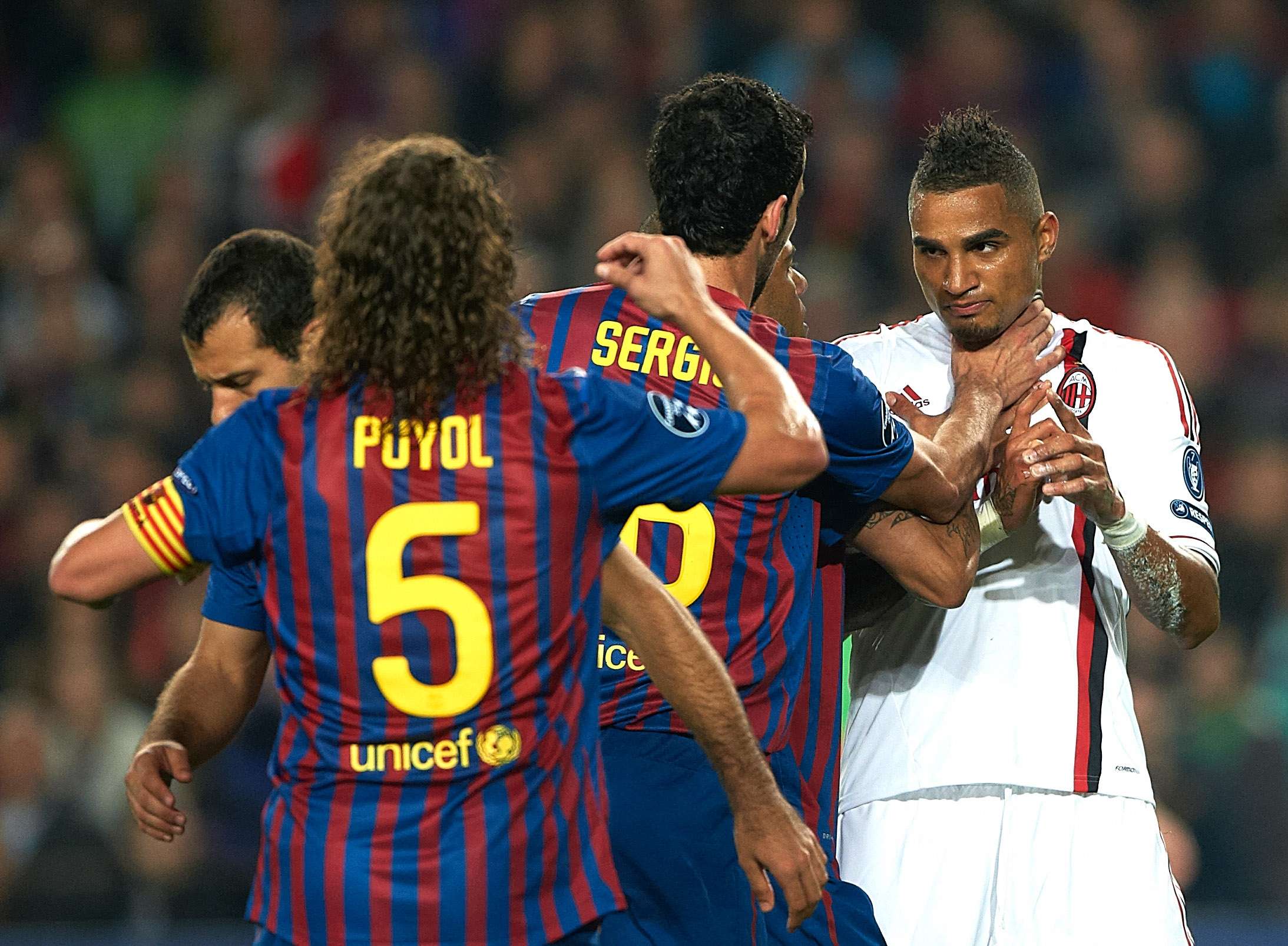Every Champions League season contains one hugely controversial game, and in the 2011-12 edition it was between Barcelona and AC Milan in the quarterfinal second leg at Camp Nou.
With the scores locked at 1-1, after Antonio Nocerino had cancelled out Lionel Messi's penalty opener, the Italians were leading the tie on away goals. But the complexion of the encounter changed completely just five minutes before half time when referee Bjorn Kuipers awarded Barca another spot-kick, the Dutch ref penalizing Alessandro Nesta for pulling the shirt of Sergio Busquets.
Messi made no mistake from 12 yards, and Milan could never recover from the psychological blow as Barcelona went on to win 3-1 and book its place in the semifinals for a record fifth consecutive season.
The second penalty caused outrage in many circles - particularly in Milan and Italy. Rossoneri striker Zlatan Ibrahimovic cried conspiracy and accused UEFA of designing a final between Barcelona and Real Madrid. Teammates Nesta, Clarence Seedorf and coach Massimiliano Allegri all criticized Kuipers too.
Barcelona boss Pep Guardiola has hit back at the negative press, claiming the foul on Busquets was clear.
But was it? Below Goal.com breaks down the controversial incident frame by frame to see if Kuipers made the right call.
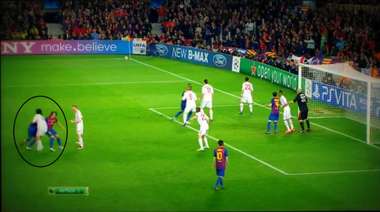
In this first frame, Nesta is clearly holding and grabbing Busquets as the Barcelona midfielder attempts to spin the Italian and make a run towards goal.
At the corner spot, Xavi is just beginning his run-up as he prepares to take the set-piece. As the ball is out of play, Nesta's shirt-tugging up until this point cannot be punished with a penalty.
FIFA's 2011/2012 Laws of the Game state: "A penalty kick is awarded if [an offense is] committed by a player inside his own penalty area, irrespective of the position of the ball, provided it is in play."
"Provided it is in play" are the key words in this instance. As the ball is dead, no offense has been committed yet.
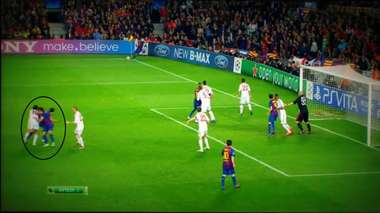
In this second frame, Xavi is just about to strike the corner. Nesta continues to pull Busquets back, but decisively Carles Puyol has moved into the Italian's path and also starts to commit an infringement against the AC Milan veteran.
As the ball remains dead, the referee is still unable to award a penalty based on FIFA's Laws of the Game. At this point, what Kuipers should have done is blow his whistle, halt the restart, and go and speak to Nesta, Busquets and Puyol.
This is the procedure referees are instructed to follow when there are shenanigans in the box prior to a corner or free kick. Kuipers should have warned Nesta - and the Barca duo - and even could have chosen to take his book out. The referee would then have been able to whistle again for the corner.
In his post-match interview, Clarence Seedorf explained how he asked Kuipers why he had given the penalty. The official's response was that he had already warned Nesta about pulling in the box. This isn't noticeable in the 40 minutes prior to this incident, but if Kuipers had indeed earlier ticked Nesta off, why didn't he stop play before the corner and book the ex-Lazio captain? Nesta was holding Busquets for almost four seconds before Xavi struck the ball.
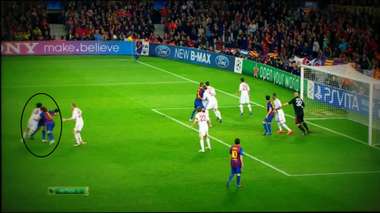
The moment Xavi connects with the ball, Nesta desperately attempts to prevent Busquets from escaping him, but he loses a quarter of a yard. Puyol has both hands around Nesta, and grabs the Italian's midriff as he tries to halt his opponent's chase.
As the ball is finally in play, any offenses that take place can now be punished with a penalty to Barcelona or a free kick to Milan.
At worst - from Milan's point of view - both Nesta and Puyol are committing fouls. In the view of the referee, one foul should cancel out the other. 'Six of one, half a dozen of the other' is a soccer idiom often uttered in scenarios such as these.
At best - Milan could argue that Nesta was only really pulling Busquets before the ball was struck. Either way, Puyol's transgression is clear.
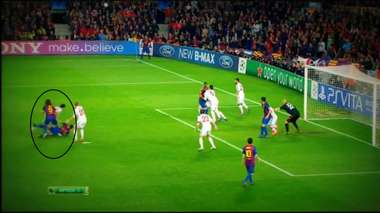
In the final frame, the coming together between Puyol, Nesta and Busquets results in the latter hitting the floor. Nesta just manages to stay on his feet after being thrown off balance by Puyol.
By now, Kuipers has already put his whistle to his mouth in order to award the penalty and book Nesta. Messi steps up and sends goalkeeper Christian Abbiati the wrong way to put Barcelona ahead again at 2-1.
To conclude the findings of this frame-by-frame analysis, the spot-kick should not - by the letter of the law - have been granted for three main reasons.
Firstly and most importantly, a penalty cannot be awarded if the ball is out of play at the time of the infraction. Secondly, Kuipers should have halted the restart to warn, or book, Nesta for time-wasting. The referee had ample opportunity to do this as Nesta was holding Busquets for almost four seconds before the corner came in. Thirdly, when the ball is back in play - and a penalty can be awarded - Puyol is fouling just as much as Nesta, if not more.
So that ends the argument, once and for all!
Follow Carlo Garganese on
With the scores locked at 1-1, after Antonio Nocerino had cancelled out Lionel Messi's penalty opener, the Italians were leading the tie on away goals. But the complexion of the encounter changed completely just five minutes before half time when referee Bjorn Kuipers awarded Barca another spot-kick, the Dutch ref penalizing Alessandro Nesta for pulling the shirt of Sergio Busquets.
Messi made no mistake from 12 yards, and Milan could never recover from the psychological blow as Barcelona went on to win 3-1 and book its place in the semifinals for a record fifth consecutive season.
The second penalty caused outrage in many circles - particularly in Milan and Italy. Rossoneri striker Zlatan Ibrahimovic cried conspiracy and accused UEFA of designing a final between Barcelona and Real Madrid. Teammates Nesta, Clarence Seedorf and coach Massimiliano Allegri all criticized Kuipers too.
Barcelona boss Pep Guardiola has hit back at the negative press, claiming the foul on Busquets was clear.
But was it? Below Goal.com breaks down the controversial incident frame by frame to see if Kuipers made the right call.
| FRAME 1: NESTA FOULING OUT OF PLAY |

In this first frame, Nesta is clearly holding and grabbing Busquets as the Barcelona midfielder attempts to spin the Italian and make a run towards goal.
At the corner spot, Xavi is just beginning his run-up as he prepares to take the set-piece. As the ball is out of play, Nesta's shirt-tugging up until this point cannot be punished with a penalty.
FIFA's 2011/2012 Laws of the Game state: "A penalty kick is awarded if [an offense is] committed by a player inside his own penalty area, irrespective of the position of the ball, provided it is in play."
"Provided it is in play" are the key words in this instance. As the ball is dead, no offense has been committed yet.
| FRAME 2: NESTA AND PUYOL FOULING OUT OF PLAY |

In this second frame, Xavi is just about to strike the corner. Nesta continues to pull Busquets back, but decisively Carles Puyol has moved into the Italian's path and also starts to commit an infringement against the AC Milan veteran.
As the ball remains dead, the referee is still unable to award a penalty based on FIFA's Laws of the Game. At this point, what Kuipers should have done is blow his whistle, halt the restart, and go and speak to Nesta, Busquets and Puyol.
This is the procedure referees are instructed to follow when there are shenanigans in the box prior to a corner or free kick. Kuipers should have warned Nesta - and the Barca duo - and even could have chosen to take his book out. The referee would then have been able to whistle again for the corner.
In his post-match interview, Clarence Seedorf explained how he asked Kuipers why he had given the penalty. The official's response was that he had already warned Nesta about pulling in the box. This isn't noticeable in the 40 minutes prior to this incident, but if Kuipers had indeed earlier ticked Nesta off, why didn't he stop play before the corner and book the ex-Lazio captain? Nesta was holding Busquets for almost four seconds before Xavi struck the ball.
| FRAME 3: PUYOL AND NESTA FOULING IN PLAY |

The moment Xavi connects with the ball, Nesta desperately attempts to prevent Busquets from escaping him, but he loses a quarter of a yard. Puyol has both hands around Nesta, and grabs the Italian's midriff as he tries to halt his opponent's chase.
As the ball is finally in play, any offenses that take place can now be punished with a penalty to Barcelona or a free kick to Milan.
At worst - from Milan's point of view - both Nesta and Puyol are committing fouls. In the view of the referee, one foul should cancel out the other. 'Six of one, half a dozen of the other' is a soccer idiom often uttered in scenarios such as these.
At best - Milan could argue that Nesta was only really pulling Busquets before the ball was struck. Either way, Puyol's transgression is clear.
| FRAME 4: PENALTY OR NO PENALTY? |

In the final frame, the coming together between Puyol, Nesta and Busquets results in the latter hitting the floor. Nesta just manages to stay on his feet after being thrown off balance by Puyol.
By now, Kuipers has already put his whistle to his mouth in order to award the penalty and book Nesta. Messi steps up and sends goalkeeper Christian Abbiati the wrong way to put Barcelona ahead again at 2-1.
To conclude the findings of this frame-by-frame analysis, the spot-kick should not - by the letter of the law - have been granted for three main reasons.
Firstly and most importantly, a penalty cannot be awarded if the ball is out of play at the time of the infraction. Secondly, Kuipers should have halted the restart to warn, or book, Nesta for time-wasting. The referee had ample opportunity to do this as Nesta was holding Busquets for almost four seconds before the corner came in. Thirdly, when the ball is back in play - and a penalty can be awarded - Puyol is fouling just as much as Nesta, if not more.
So that ends the argument, once and for all!
Follow Carlo Garganese on
